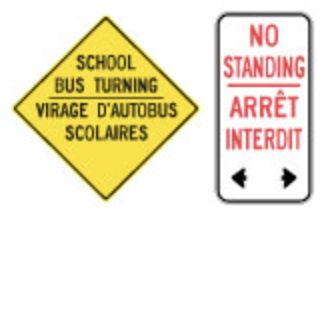The Signs - Handbook
- Temporary condition signs
- These signs warn of unusual temporary conditions such as road work zones, diversions, detours, lane closures or traffic-control people on the road. They are usually diamond-shaped with an orange background and black letters or symbols.
Here are some common temporary condition signs:
- Construction work one kilometre ahead.

- Road work ahead.

- Survey crew working on the road ahead.

- Traffic control person ahead. Drive slowly and watch for instructions.

- You are entering a construction zone. Drive with extra caution and be prepared for a lower speed limit.

- Temporary detour from normal traffic route.

- Flashing lights on the arrows show the direction to follow.

- Pavement has been milled or grooved. Your vehicle's stopping ability may be affected so obey the speed limit and drive with extra caution. Motorcyclists may experience reduced traction on these surfaces.

- Lane ahead is closed for roadwork. Obey the speed limit and merge with traffic in the open lane.

- Closed lane. Adjust speed to merge with traffic in lane indicated by arrow.

- Do not pass the pilot or pace vehicle bearing this sign.

- Reduce speed and be prepared to stop.
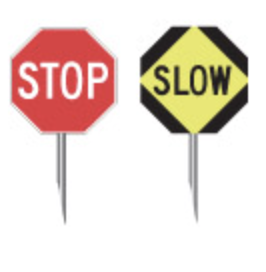
- Follow detour marker until you return to regular route.

- Enforces doubling the HTA fines for speeding in a designated construction zone when there are workers present.

- Information and direction signs:
These signs tell you about distances and destinations. They are usually rectangular with a green background and white letters. Other signs with different colours guide you to facilities, services and attractions.
Here are some common information and direction signs:
Shows directions to nearby towns and cities.

- Shows the distances in kilometres to towns and cities on the road.
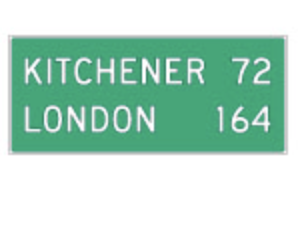
- Various exit signs are used on freeways. In urban areas, many exit ramps have more than one lane. Overhead and ground-mounted signs help drivers choose the correct lane to exit or stay on the freeway.
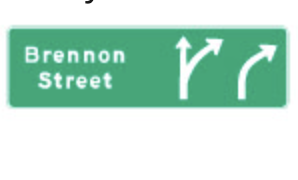
- Advance signs use arrows to show which lanes lead off the freeway. Signs are also posted at the exit.

- Sometimes one or more lanes may lead off the freeway. The arrows matching the exit lanes are shown on the advance sign in a yellow box with the word 'exit' under them.
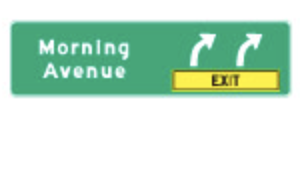
- Freeway interchanges or exits have numbers that correspond to the distance from the beginning of the freeway. For example, interchange number 204 on Highway 401 is 204 kilometres from Windsor, where the freeway begins. Distances can be calculated by subtracting one interchange number from another.

- The term 'VIA' is used to describe the roads that must be followed to reach a destination.
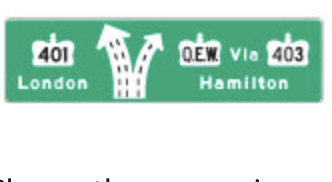
- Shows the upcoming roundabout exists and where they will take you.

- These signs change according to traffic conditions to give drivers current information on delays and lane closures ahead.

- Shows off-road facilities such as hospitals, airports, universities or carpool lots.

- Shows route to passenger railway station.

- Shows route to airport.
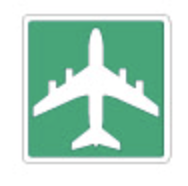
- Shows route to ferry service.

- Shows facilities that are accessible by wheelchair.
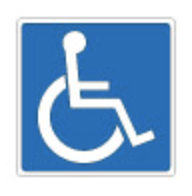
- Oversize load sign:
Vehicles and/or loads in excess of dimensions prescribed under Section 109 of the Highway Traffic Act must be marked with bright red or orange warning flags, which are at least 40 cm square, mounted to the extremities of the vehicle or load. The flag(s) must be kept in good and clean condition so as to not diminish their effectiveness.
In addition to flags, vehicles and/or loads must display on the front of the vehicle and the rear of the load, in a clearly visible position, either one of the two following signs: a sign visible for a distance of at least 150 metres bearing the words “OVERSIZE LOAD” in black letters at least 200 millimetres high on a yellow background; or, a “D” sign, as illustrated. When travelling at night, the sign must be made of high-intensity, retro-reflective material. The sign cannot obstruct lights or other safety devices on the vehicle or trailer; and it must be removed or covered when not in use.

- The “slow-moving vehicle” sign is an orange triangle with a red border. It alerts other drivers that this vehicle will be travelling at 40 km/h or less. When on a road, farm tractors, farm implements/machinery and vehicles not capable of sustaining speeds over 40 km/h must display the slow moving vehicle sign. Watch for these slow moving vehicles and reduce your speed as necessary.

- When transporting dangerous goods, safety marks, placards or labels are displayed to identify dangerous-goods classification and the nature of danger they pose. They are an information tool to provide a quick identification that can be found on trucks, cargo and even pallets.
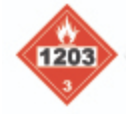


- This placard indicates a long commercial vehicle, which is a double trailer and can be up to 40 metres in length. It is important to be able to recognize an LCV on the highway, based on rear signage, and anticipate both extended length and limited speed when preparing to pass one on the highway.

- EDR signs are used during the unscheduled closure of a provincial highway when OPP detour all traffic off the highway. The EDR markers are located along alternative routes and provide direction to motorists around the closure and back onto the highway.
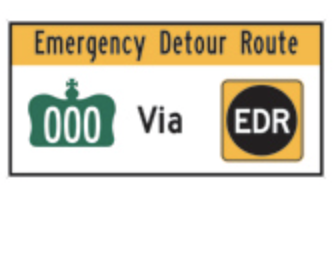
- Some information signs include a numbering system along the bottom of the sign to assist emergency vehicles and drivers in determining an appropriate route.
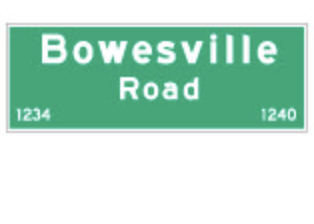
- Watch for these signs when driving in designated bilingual areas. Read the messages in the language you understand best. Bilingual messages may be together on the same sign or separate, with an English sign immediately followed by a French sign.
